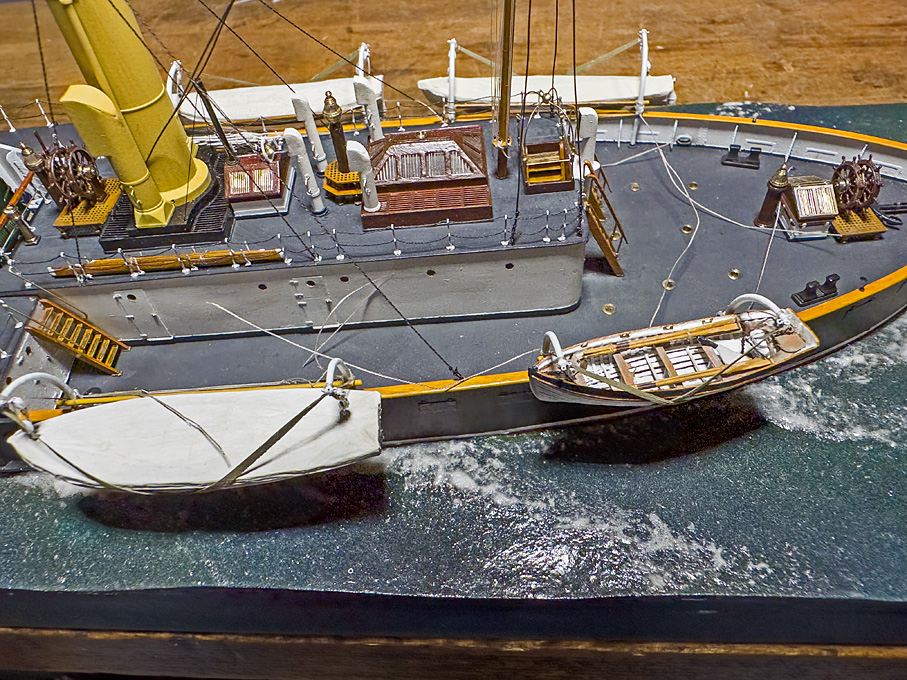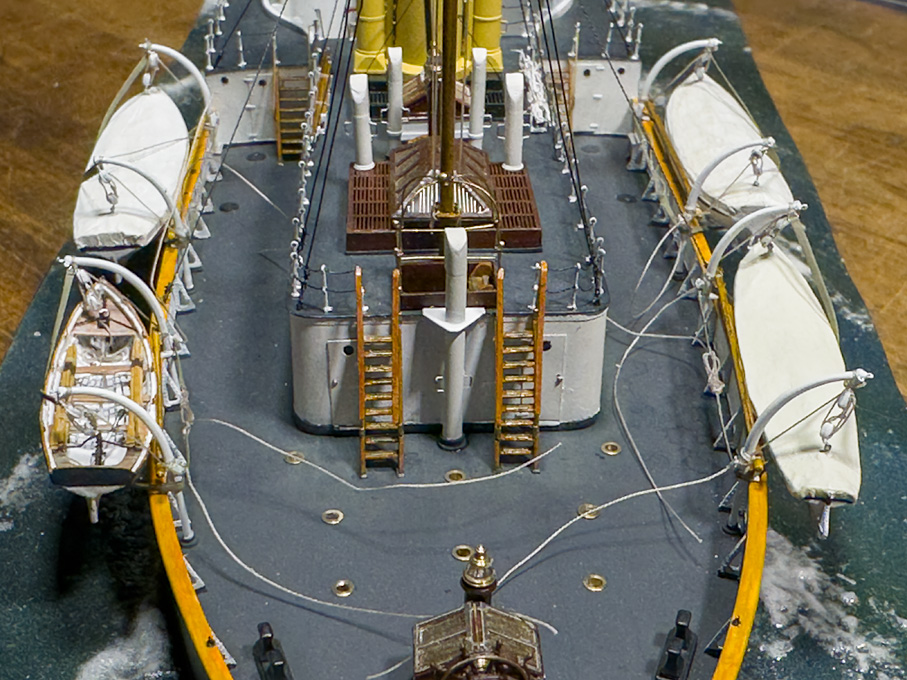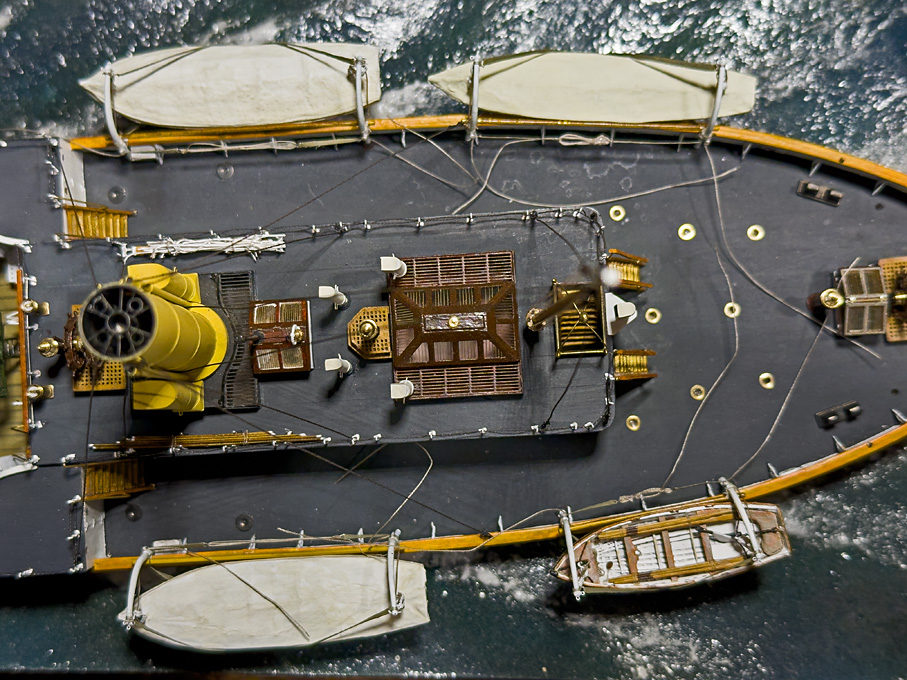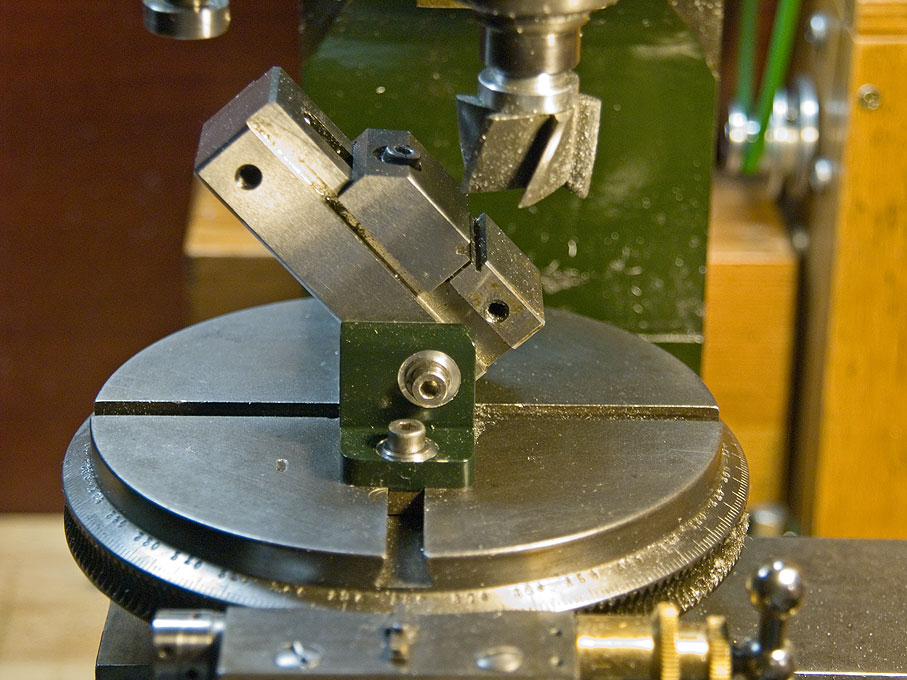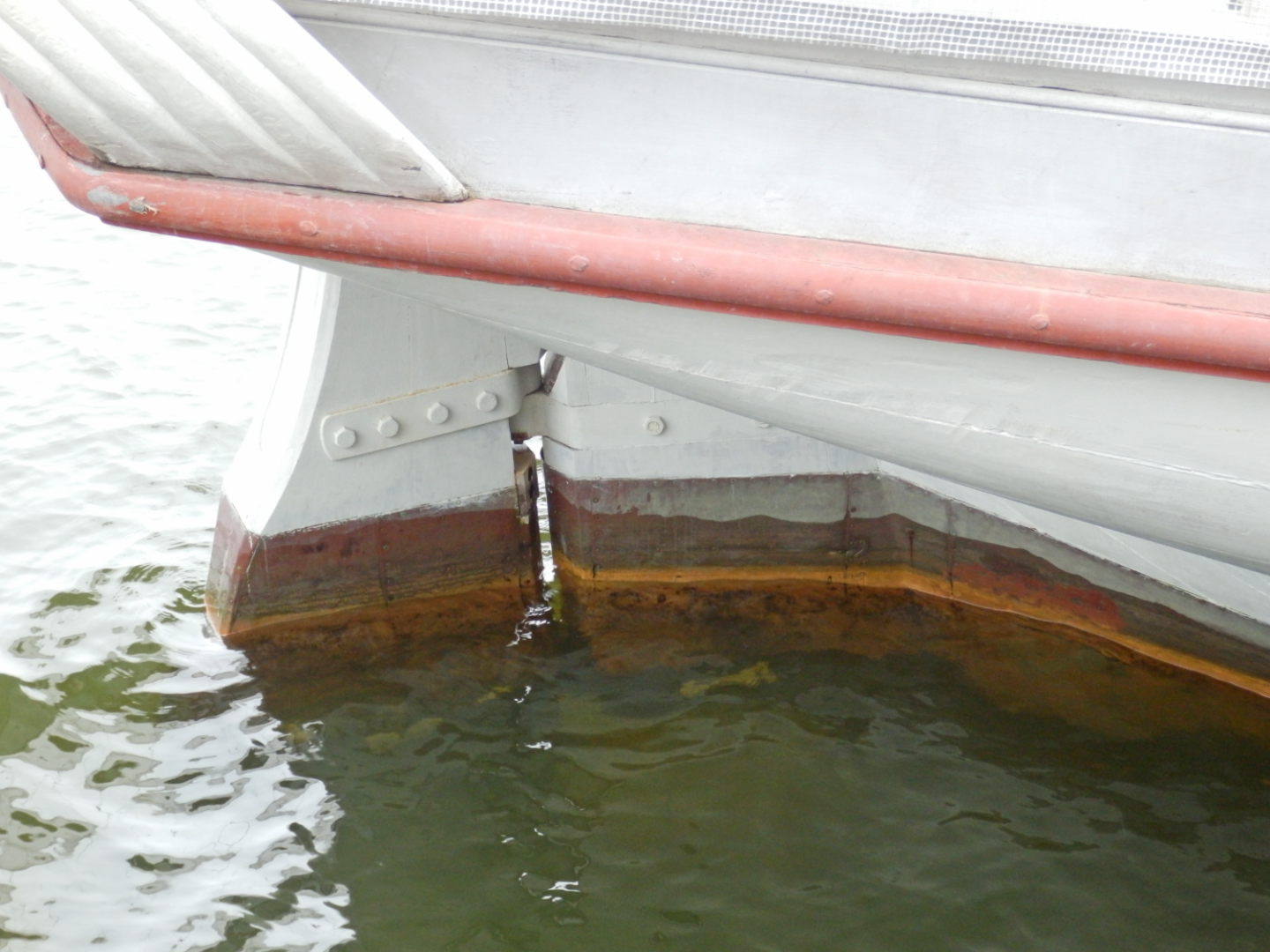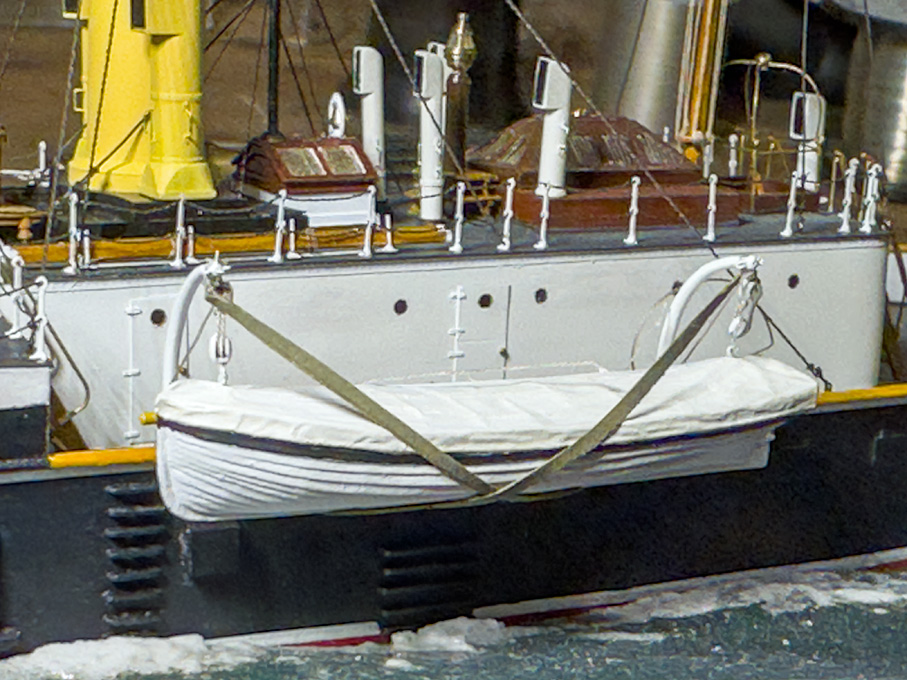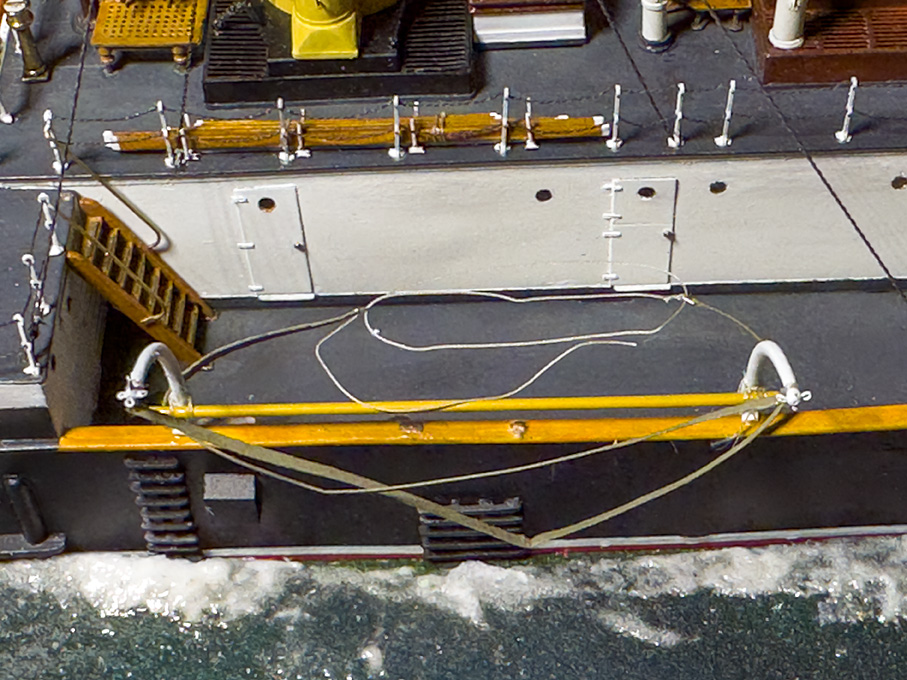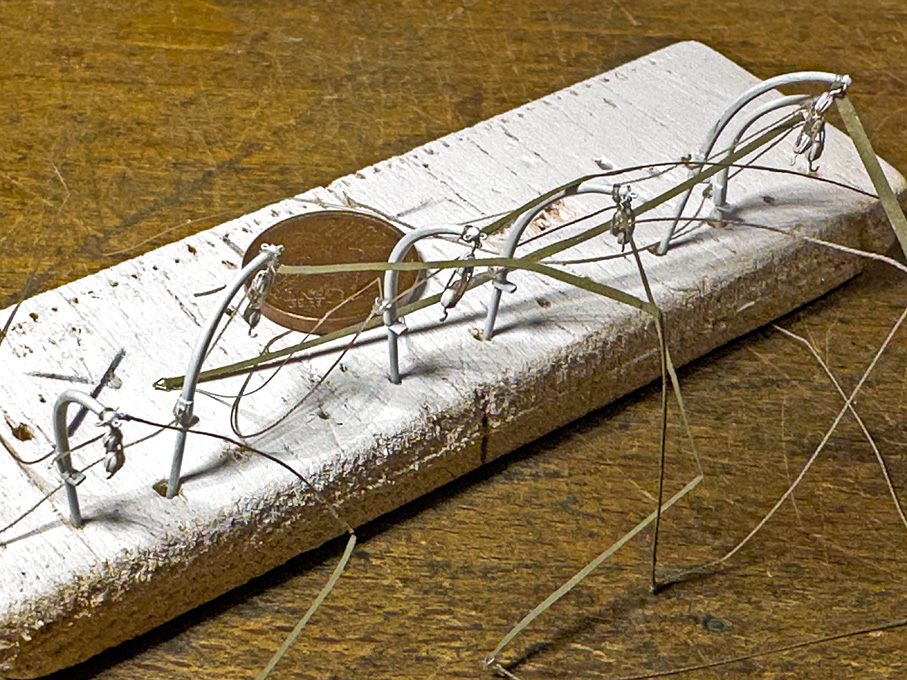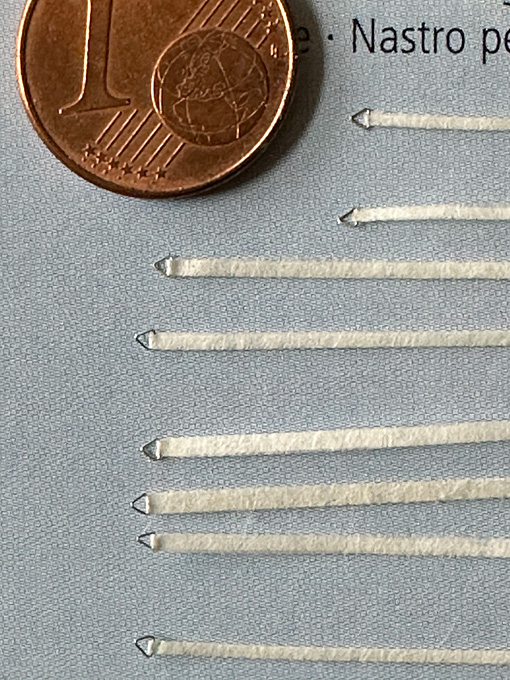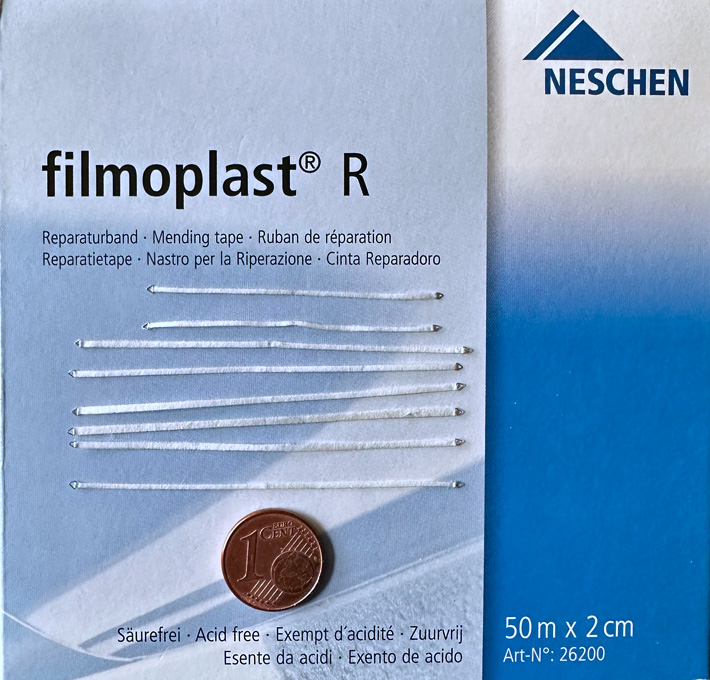-
Posts
6,644 -
Joined
-
Last visited
Content Type
Profiles
Forums
Gallery
Events
Everything posted by wefalck
-
Thanks, Ab, much appreciated ! ********************************* Installing the ship’s boats 2 It is done! All four boats are suspended from their davits and the work was achieved without major damage to other parts. Good thing that there is not (yet) any brain recorder … because of the mental language that accompanied the process at certain stages. Still there is a lot to be done, such as tidying up the loose ends, making and installing the coils of rope from the runners of the boat-tackles and the longitudinal chain-stays for the davits. To be continued ....
-

Pulled the Trigger == Lathe coming
wefalck replied to kgstakes's topic in Modeling tools and Workshop Equipment
Well, I would rather first get a bit of experience in turning, as the quality of all your parts depends rather on the precision with which you have turned down the jaws. You would need a round piece of very good quality, such a ground piece of tool-steel. Onto this you tighten the jaws and then you can turn the outside of the jaws. However, you just end up with a set of stepped soft jaws. If it was me, I would get myself one of those self-centring chucks from Sherline - I think they do them with the right thread for the Taig, but I am not sure. I have several of those Sherline chucks and they are perfectly adequate for our kind of work. Having said that, I find that I rarely use the 3-jaw-chucks for modelling work, they are mainly used for tool-making. Whenever possible, I use collets. much safer to work with. -

What kind, brand and where do you buy your end mills?
wefalck replied to rlb's topic in Modeling tools and Workshop Equipment
Yep, a milling machine can be used for turning as well. For amateurs, military field-use or on board of small ships in history, combination machines were developed (see www.lathes.co.uk) that could do turning, boring, and milling with little or no change of set-up. With modern CNC-machines the distinction between these operations also has faded away, as the work-piece would be chucked onto driven axes and then driven or stationary tools applied. Another example for this 'relativity' is that lathe boring-bars can be used in a boring-head on a milling-machine ... For the moment I am well kitted-out, but I used to be always on the look-out on ebay for lots of such carbide tools discarded by industry. There are small traders who buy them off industrial companies in bulk and then sell them in amateur-sized lots. You may get good cutters for less than 1 EUR/USD/GBP per piece. OK, wood can dull cutters quickly, but they usually lasted me for years. -
Roger, not sure that your conclusions are all correct. There was intermediate period in iron- and armoured-ship development, when they reverted back to composite construction. There were two reasons: one was that in experiments (these are e.g. documented for France in the Aide mémoire de l’artillerie naval 1873ff) it was found that when armour plates were attached directly to the ships structures, the impact of projectiles weakend these structures; a wooden backing provided a sort of resilient buffer that distributed the stresses. On the other hand, iron hulls fouled fast and it wasn't until 1860 that the Bremen captain Rathjen developed the classical red-oxide coloured anti-fouling paint that contained arsenic and mercury compounds. In the late 1860s already other colours became available. Nevertheless many navies around the world relied on copper- or Munth-metal-sheathing well into the 1890s. For reasons of galvanic corrosion, these could not be attached directly to iron plating, so that iron hulls were first sheathed in wood, onto which the copper or Muntz-metal was applied. I am not aware that zinc sheathing was used on iron ships. I think it would have been eaten away very quickly by galvanic corrosion, if there were any metal parts on the ship exposed to the water. After all, this is way today we put sacrifical zinc anodes onto our ships. The French sources are quite good and one should e.g. scan the Atlas du Genie Maritime etc. for cross-section of hulls of ships of this time in order to see how they were constructed. A wooden ship stationed in China almost certainly would have to be metal-sheathed, as much of the Chinese waters are sub-tropical. Note: I wrote this while Shipific posted his response. You may also want to have look at my images of builders' models of ships of that period in the museum in Paris: https://www.maritima-et-mechanika.org/maritime/paris/frenchironclads.html
-

What kind, brand and where do you buy your end mills?
wefalck replied to rlb's topic in Modeling tools and Workshop Equipment
This is now a bit of thread-drift, but coming back to those down-cut carbide cutters: I got them by accident among a bunch of up-cut ones in a lot - some production industries (circuit-board manufacturers, aerospace, etc.) change their cutting tools regularly in order to avoid spoiled parts and unscheduled down-times. Such tools are still good enough for our puposes because they have been changed before they become dull. Such lots appear frequently on ebay. The shank diametres are usually imperial, i.e. 1/4", 3/16", and 1/8". The best use in my workshop for the down-cut ones is as very stiff boring-bars on the lathe, preferably in through-holes. They work on any kind of material a shipmodeller is likely to encounter. They would also work for side-milling or milling of rabbets or basically anything, where the chips can be thrown out sideways easily. However, the up-cut bits are much more versatile in any case and I would only look for them. -

What kind, brand and where do you buy your end mills?
wefalck replied to rlb's topic in Modeling tools and Workshop Equipment
Unlike toolmaker it seems, I am a mere self-taught amateur ... -
Well, when you tighten a vice the loose jaw often has the tendency to lift or when the guides of the loose jaw have too much play, the jaw can move sideways when tightened. Both the fixed and loose jaw should also close tight and precisely when tightened without a workpiece in it. Finally, the edge of the fixed jaw should be precisely aligned with the body of the vice, so that you can align it easily on the mill table. The mentioned toolmaker's vices don't have a spindle to tighten the loose jaw, but the jaw is pulled down- and forward by a screw that screws into a sort of 'toggle' underneath the vice. This make the vice also a lot shorter, as there is no spindle sticking out. Here is a picture of such vice (in my shop-made tilting device:
-

What kind, brand and where do you buy your end mills?
wefalck replied to rlb's topic in Modeling tools and Workshop Equipment
I am coming more from the metal side, where the terms conventional and climb-milling are used. As toolmaker has pointed out there are end-mills that have one cutting edge that cuts over the centre, these are the ones that can be used for 'plunging' into material (like you do for a drill). Other end-mill can only be used for side-milling. The only end-mills I have ever come across in practice that do 'down-cut' are certain single-lip carbide cutters. Everything else I have encountered transports the cut material upwards. I am not quite sure for what application the 'down-cut' single-lip carbide cutters were meant for - I got them by accident. When milling in wood, it is important to have a cutter with a lot of room for chips, which is why router bits typically have only two lips. Three- to four-(or more) lip cutters are for metal. You also want a cutter with a steep spiral to lift the chips quickly out of the slot. The ubiquituous two-lip carbide end-mills with 1/8" or 1/4" shaft are probably good for most wood applications, if run fast enough. -

What kind, brand and where do you buy your end mills?
wefalck replied to rlb's topic in Modeling tools and Workshop Equipment
What do you mean by up-cut resp. down-cut? -

Help with understanding the rigging diagram
wefalck replied to Linda DOBLE's topic in Masting, rigging and sails
One problem we have today is that with the demise of sailing ship as commercial carrier around WW1 also treatise on masting and rigging stopped to be written. So there is not much literature on full-scale practice post 1900. Probably the reference book most applicable to AMERIGO VESPUCCI would be: MIDDENDORF, F.L. (1903): Bemastung und Takelung der Schiffe.- 401 p., Kassel (reprint 1977 by Horst Hamecher). but it is in German and no digital copies are available (to my knowledge), as there seems to be still some copyright on it. The next best source then and one addressing the needs of the shipmodeller would be: UNDERHILL, H.A. (1946): Masting & Rigging the Clipper Ship & Ocean Carrier.- 304 p., Glasgow (Brown, Son & Ferguson). He focussed on late(r) 19th century commercial ships, not naval practice. Again no digital copy due to being still copyrighted. There are many textbooks on rigging from the second half of the 19th century, including for naval practice, but since then things have evolved a lot (more wire rope in particular, not only for the standing rigging). I must admit, I have never looked for Italian text books on rigging (though I do speak Italian). The closest would be Orazio Curti's book on shipmodelling, but he mainly uses mid- to late 19th century illustrations. Curti actually re-rigged the training schooner EBE from the 1920s that has been put up in the Museo della Scienza e Technologia in Milan. But she is a much smaller ship than the AMERIGO VESPUCCI ... I have to get around to put the detailed pictures I took of her last year onto my Web-site. -
Somehow, I had the opposite experience: when the lady, who now has been my wife for 16 years, first saw my workshop, she called it a 'torture chamber'. At some stage I also noticed these 'derma-rollers' on ebay, but found that the needles are pitched to wide (for my scale) - it's sometime interesting to browse the 'nails' and 'beauty' categories on ebay, as there may be useful 'tools' (if you are not put off by their garish colours).
-
Is the vice an integral part of the x/y-table ? I prefer so-called 'toolmakers insert vices' on my machines, which are available down to 20 mm jaw-width and then are about 25 mm high. They cost in the order of 40€/US$/L and are very precise. BTW, I don't like turning sleeves on the handles, they don't give you a very positive 'feel' for what happens. Also on this table they seem to be excessively long, around 20 mm would be enough. The longer the handle the longer the lever with which you jerk on the table, which reduces precision.
-
This is an image of the replica-brig TRE KRONOR in Stockholm: She has been prepared for the winter and has not moved for several months, as the picture was taken in early April 2015. The Baltic sea around Stockholm has a rather low salinity, about half the mean ocean salinity. This may be reflected by the absense of verdigris, but I don't have data for the sulfate content of Baltic seawater at the tip of my fingers. One should start a research project and make some experiments by suspending some copper-sheets, produced the same way as in the old days, in different types of seawater under different climatic conditions in order to see what happens.
-
Pat, I don't have hands-on experience with drafting linen, only know it from some old drawings in archives. However, I think the thinner the material, the better. Such canvas straps would be perhaps 3 mm thick at most in real life.
-
I think Bob above with his reasoning is right. I would expect the copper to be a dullish penny-brown below the water line, some verdigris (i.e. copper sulphate-oxide) around the waterline and again some more penny-brown higher up, depending on how much above the waterline the coppering goes. Incidentally, the bronze ram and stern-post should retain a more yellowish colour, perhaps with a hint of brownish green - the tin in the bronze doesn't really form sulfates in seawater conditions.
-
Thanks, gentlemen, for your kind comments! Pat, I obtained the tape from a local art supply store. Here is the link to the manufacturer's Web-site: https://www.neschen.de/en/product/filmoplast-r/#pdetails. They probably sell world-wide, but I would suspect that there are other manufacturers with similar products. Basically it is an extremely thin silk-paper to which a film of heat-activated acrylic compound is attached. This acrylic film actually detached quite easily and could be used even for other applications.
-
Shellac solution has been used for centuries to stiffen paper. You will have to experiment with the right alcohol to shellac ratio. I use a thick solution as glue.
-
I don't think there is one type of card that fulfills all the requirements one may have. I hasten to add that I am not 'cardboard-modeller', but I use card in my models. This is a huge difference. Cardboard-modellers, at least those working from kits, do not normally paint or otherwise surface-coat their models, while I do. A key question is: do you care about acidity and cheap wood in the cardboard or don't you care about the longevity of your model. A lot of cheap cardboard in not neutralised in terms of pH and, therefore, the material may/will disintegrate with time. I would always go for high-quality material from artist supply shops. Personally, I prefer high-density papers that have been calandred heavily (i.e. pressed strongly between steel rollers) to give a smooth surface. The name to look out for is Bristol-board, which is available in different thicknesses, i.e. different weights per sqm. Unfortunately, my cheapo 3W laser-printer cannot handle white dense paper. The best solution I found is dark-brown 'Canson'-paper. This is less dense than Bristol-board, but still has a reasonably smooth surface. In fact, I create a sort of composite material by soaking the Canson-paper in varnish. Other people use thin CA glue, but I am not fond of CA. The varnish gives the paper a limited capability to be sanded. One may need to resoak the paper at the sanded edges to stabilise them and reduce the 'fuzz'.
-
Thanks, belatedly, gentlemen ... Well, some traveling and struggles with tiny and flimsy parts caused again a long delay until this update … Installing the ship’s boats This detail was the most dreaded of all, due to the flimsy character of the parts. The davits had been produced a long time ago, as were the blocks for the hoisting tackle, and, of course the four boats. There are no pictures, except the very first photograph of SMS WESPE that indicate the arrangements for the boats hanging outboard on the davits. While it seems to have been a quite common arrangement on smaller warships of the time, it was already noted in reports by captains of Prussian gunboats ten years earlier, boats in such a position are prone to be carried away by seas of even moderate height. So, quite early on barrings and boat skids had been installed on the WESPE-class boat and the davits lengthened to lift up the boats. For this final arrangement, various images are available. Somehow, the boats must have been prevented from swinging in their hoisting gear. A typical arrangement would have been a spar lashed across the davits and the boats pulled against them with cross-wise boat ties. In the absence of other pictorial evidence, this is what I opted for. There were, however, still some detail questions open: were those ties strips of heavy canvas or braided rope-work and did the spars have bolsters around them to prevent damage to the boats? For the latter questions there are examples of both option on photographs and (contemporary) models. I recently visited again the Maritime Museum in Stockholm, which reminded me of a possible solution on a model of the same period. The boat-ties seem to have been heavy canvas and had triangular rings at their ends. They are attached to an eye at the top of the davit, run around the boat, then around the opposite davit, and are hauled taught with a tackle of blocks hooked in between them. No bolsters on the spars. I decided to leave out the tackle and just use a lashing between the rings to tighten the ties. The lashing will be difficult enough to access behind the boats. Boat ties arranged on a package of book-repair tape The triangular rings were fashioned from 0.15 mm tinned copper-wire wound around the tang of a triangular file with 1 mm sides. The windings were cut open with a scalpel. The ties themselves are narrow strips of a special kind of material: a kind of very fine silk-paper tape with a backing of a thermos-setting acrylic glue. This material is used in book repair for instance. Brand and other details can be seen on the photograph. The 1 mm strips were cut with a new no. 11 scalpel blade and folded in two. The material is slightly tacky which is helpful when aligning the halves and inserting the rings. The glue was set with the help of my hot-air soldering gun set to 110°C as per instructions. The halves were pushed together using a tool as used in the old days to rub down transfer lettering. The ties were painted in Vallejo ‘hemp’. Boat ties in detail It took some tries to work out a workable sequence for installing the davits, spar, boat-ties and boat-tackles, considering also the difficulty of access. Eventually the ties were fastened to the davits and the tackles hooked into the latter with the loose end already belayed to the clamp on the back of the davits. Davits fitted out and ready for installation on board The davits then were inserted into their sockets and fixed with a drop of white glue. Next the spar is lashed to the davits. Then the ties were arranged in preparation of the boats and the lashing is reeved. Davits ready to receive the boat. The davits are now ready to receive the boat, which is slipped in and the tackles hooked into the respective rings on the boat. The ties are now pulled tight, so that boat rests against the spar. Boat stowed in the davits. Overall, the installation of the first boat went reasonably well. However, it is hanging a few millimetres too low. The boat’s keel should have been level with the bulwark handrail. Somehow, I didn’t manage to make the close-hauled tackled as short as it should have been. Also, the hooks on the blocks are a tad too long. Not 100% satisfactory, but I am not going back two steps to remake the blocks and tackles and all. Let’s assume the crew hasn’t done such a good job in stowing the boats and the officers haven’t noticed it yet … To be continued ....
-
It's not the rod that flexes, but possibly the rod in the base-plate ...
-

Pulled the Trigger == Lathe coming
wefalck replied to kgstakes's topic in Modeling tools and Workshop Equipment
Well, it's difficult to give here a crash-course in turning ... most of the time one would cut towards the chuck, as the main spindle-bearing is designed to take up the cutting forces. However, there are many situations, when one needs to cut away from the chuck, but one would do this for as little material as possible. For the smal pieces in modelling and working with easily turned materials, such as brass or aluminium, a life centre is not really needed, a hard fixed centre is the more precise option. Always lubricate well. When turning wood, the situation is different, as one cannot lubricate and the friction between wood and steel is considerable. So a life centre is needed for longer parts. You probably will find an aftermarket life centre with an arbor of the same diametre as you already have. To my knowledge, the Taig lathe is not bored for any Morse-taper tooling, neither in the spindle nor the tail-stock. Except for MT0 all the MTs would be too large for this small lathe. There are various degrees of freedom, when aligning a lathe: the height and angle (vertical and horizontal) of the spindle relative to the bed ways, the height and angle (vertical and horizontal) of the tailstock axis, the straightness of the bed etc. Most of them are set by the manufacturing tolerances of the lathe and it is not so easy to correct these. So having a test-bar may not be terribly useful, as any corrections (if needed at all) would involve an extensive scraping or shimming action. However, the Taig tailstocks can be 'set-over' for taper-turning, i.e. moved perpendicular to the axis of the lathe. This means that every time you have loosened the locking screw, you would need to re-align the tailstock. An old-time machinists' approach is to use two fixed centres, in the spindle and in the tailstock, and hold a razor-blade between them. If the centres are aligned correctly, the blade should be perfectly vertical and at 90° to the bed. Otherwise, I would not get worked up too much about such alignment issues, as they are likely to be well within the tolerances we are working in. On my watchmaker-lathes I can easily work to within a 1/20 or even 1/50 of a millimetre. That should be more than good enough for shipmodelling purposes, unless perhaps you are building a steam-engine. I would guess, that on the Taig you can also work to 1/20 of a millimetre (assuming that the handwheels are graduated at 1/10 or even 1/20. -
The main body that houses the spindle as well as the table apear to be pupose-machined parts, the rest is probably off-the-shelf stuff that can be easily sourced on Amazon, ebay, etc. In fact, one could fabricate easily such a drill-press from parts sold for 3D-printers or CNC-mills. Rods and bearings can be found in all sorts of dimensions in the Internet. As to longer columns: the longer the column the more flex there is, which may be not so good for small fragile drill-bits. In fact, the melamin riser-blocks may be not such a bad idea at all.
-
I would be surprised, if the spindle used anything else than ball-bearings. Ideally there should be three: two radial ones and a third axial one to take up the force from drilling. The seats can be easily machined on a CNC mill. There would need to be a sleeve on the spindle to take up end-thrust. All in all the parts would cost only a few €/US$/£ … no point to mess around with brass bearings.
About us
Modelshipworld - Advancing Ship Modeling through Research
SSL Secured
Your security is important for us so this Website is SSL-Secured
NRG Mailing Address
Nautical Research Guild
237 South Lincoln Street
Westmont IL, 60559-1917
Model Ship World ® and the MSW logo are Registered Trademarks, and belong to the Nautical Research Guild (United States Patent and Trademark Office: No. 6,929,264 & No. 6,929,274, registered Dec. 20, 2022)
Helpful Links
About the NRG
If you enjoy building ship models that are historically accurate as well as beautiful, then The Nautical Research Guild (NRG) is just right for you.
The Guild is a non-profit educational organization whose mission is to “Advance Ship Modeling Through Research”. We provide support to our members in their efforts to raise the quality of their model ships.
The Nautical Research Guild has published our world-renowned quarterly magazine, The Nautical Research Journal, since 1955. The pages of the Journal are full of articles by accomplished ship modelers who show you how they create those exquisite details on their models, and by maritime historians who show you the correct details to build. The Journal is available in both print and digital editions. Go to the NRG web site (www.thenrg.org) to download a complimentary digital copy of the Journal. The NRG also publishes plan sets, books and compilations of back issues of the Journal and the former Ships in Scale and Model Ship Builder magazines.



